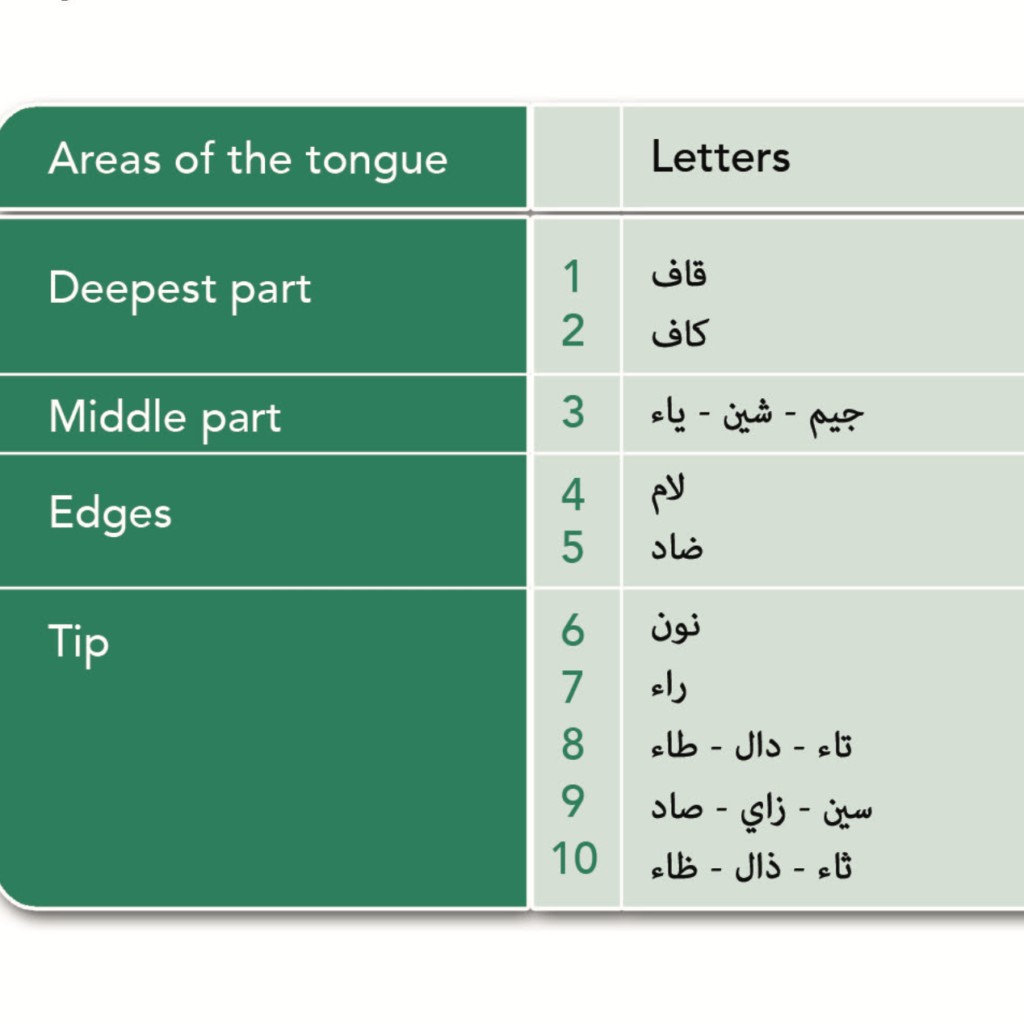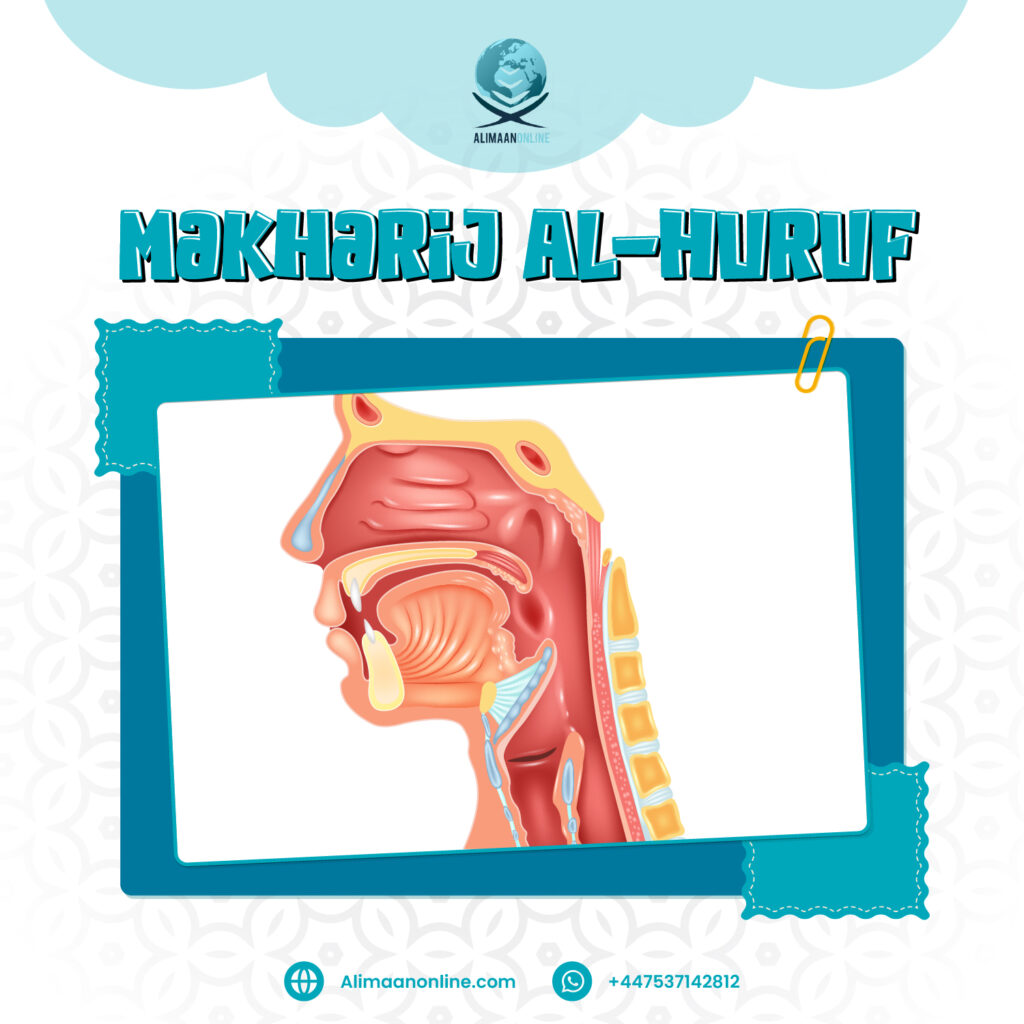Understanding the intricacies of Arabic pronunciation involves exploring the Makharij al Huruf, the articulation points where letters originate, defining their distinct sounds. Sound, a manifestation of vibrations and waves, reaches the human ear through the air, creating the rich tapestry of Arabic phonetics.
Al Makharj( The articulation point):
Makharij al Huruf: “The points of articulation, indicative of positions within the vocal tract, serve as the genesis of speech sounds. These positions delineate the unique attributes of each sound within a language. Over time, scholars have engaged in debates surrounding the number and nature of these points, offering diverse perspectives throughout history.”
According to some linguistic scholars, there are 14 points of articulation, which include categories such as Qatrib, Al-Jami, and Al-Far. However, others, like Al-Jazari and Al-Khalil Ibn Ahmad, argued for 17 points. Meanwhile, figures like Sibawayh and al-Shatibi asserted that there are 16 points, a view that gained agreement from the majority of scholars.
“Moreover, these points of articulation(.Makharij al Huruf) are crucial in phonetics and phonology, as they facilitate the explanation of speech sound production and differentiation within a language. Understanding these points not only aids in linguistic analysis but also enhances the study of phonological systems across different languages.”
The sound:
Is a group of vibrations and waves carried in the air to the human ears.
The letter:
A sound originates from a specific articulation point when pronounced.
Types of Makharij al Huruf (Articulation Points)
1-Specific Articulation Point:
- Relies on a precise location in the tongue, throat, or lips.
- Defines sounds with accuracy.
2-Approximate Articulation Point:
- Relies of an approximate articulation point like Al Jawaf.
- Applies to lengthened letters, originating from the mouth and throat’s empty space.
Determining Al Makharij (Articulation Points)
To identify the articulation point of any letter (except Medd letters):
- Place a Sukoon above the letter.
- Prefix the letter with a Hamzah.
- Add any vowel above the Hamzah.
- Pronounce the letter, noting the stopped sound to determine the articulation point. The Arabic alphabet consists of 29 letters, with the Hamza as the unnumbered letter. Understanding these pronunciations is vital in deciphering the speech system.
Major Five Articulation Areas of Makharij al Huruf
The speech system comprises five major Makharij, each associated with specific articulation points:
1-Al Jawf (The Empty Space):
- A major area in the mouth and throat.
- Originates the three Medd (lengthened) letters.
2-The Throat:
- Divided into Adnal Halq (closest part), Wasatal Halq (middle part), and Aqsal Halq (deepest part).
- Articulates six letters, each associated with a specific part of the throat.
3-The Tongue:
- Ten articulation points for eighteen letters.
- Crucial for precision in pronunciation.
4-The Two Lips:
- Comprising two articulation points for four letters.
- Shapes sound using lip movement.
5-The Nasal Cavity:
- Features one articulation point for Ghunnah (nasal sound).
- Adds depth to pronunciation.
Al Jawf (The Empty Space)
Al Jawf serves as a crucial area in the mouth and throat, acting as both a major space and an articulation point. Within this space, three lengthened (Medd) letters originate, each contributing a unique sound to the Arabic phonetic landscape.
1-ى (Ya’ with Sukoon):
- Pronounced after a letter with Kasrah.
- When pronounced, the vocal cords open, and the middle of the tongue raises close to the Makhraj of the letter “ya.”
2-و (Wow with Sukoon):
- Follows a letter with Dammah.
- When pronounced, the vocal cords open, and the lips round, similar to pronouncing the letter “wow.”
3-ا (Alif with Sukoon):
- Preceded by a letter with Fathah.
- When pronouncing, the vocal cords open, and the back of the tongue lowers for the light alif, and raises for the heavy alif.
The Throat: Adnal, Wasatal, Aqsal Halq
The throat, a pivotal region for articulating specific Arabic sounds, further divides into three distinct parts, each responsible for unique letters.
1-Adnal Halq (Closest Part):
- Articulates غ (ghain) and خ (khaa).
- Requires precision to produce distinct sounds.
2-Wasatal Halq (Middle Part):
- Gives rise to ع (ain) and ح (haa).
- Understanding the nuances of tongue placement is crucial for accurate pronunciation.
3-Aqsal Halq (Deepest Part):
- Forms the sounds of ء (hamzah) and هـ (haa).
- Mastery of articulating from the deepest part of the throat ensures clarity in pronunciation.
Navigating the Tongue’s Articulation Points

The mouth produces letters, primarily involving the tongue and its interaction with various regions of the teeth and mouth. There are four main points of articulation (makhaarij), further categorized into ten sub-categories:
- The posterior part of the tongue – with two subcategories.
- The middle of the tongue – serves as the sole makhraj for three letters.
- The lateral aspect of the tongue – features two distinct points of articulation.
- The tip of the tongue.
1-The Furthest Back Part of the Tongue – 2 Subcategories:
- ق (Qaf):Articulation: This letter is articulated from the deepest part of the tongue and what lies opposite to it, which is the roof of the mouth in the area of the soft palate.Sound: Creates a thick sound in the tonsils vicinity. (اقْ)
- ك (Kaf):Articulation: This letter is articulated from the deepest part of the tongue and what lies opposite to it, which is the roof of the mouth in the area of the hard and soft palate.Slightly in front of ق, tongue not elevated.Sound: The back of the tongue produces the sound. (اكْ)
2-The Middle of the Tongue – 3 Letters:
- ج (Jeem), ش (Sheen), and ى (Ya):Articulation: The Three letters are pronounced from the Middle part of the tongue and what lies opposite to, which is the roof of the mouth.Sound: Pronounced with the tongue’s midsection.
3-The Side of the Tongue – 2 Specific Points:
- ض (Dad):Articulation: This letter is pronounced from one or both back sides of the tongue touching the molars and the gum area next to the molars.Sound: Commonly used from the left side. (اضْ)
- ل (Lam):Articulation: Laam is pronounced from the front sides of the tongue till the end of its tip touching what lies opposite to them, which are the gums of the two upper incisors, two upper later incisors, two upper canines, and two upper premolars. Side of the tongue nearest the front of the mouth.Sound: Articulation involves the tip and side of the tongue. (الْ)
2-The Tip of the Tongue – 11 Letters:
- ن (Noon):Articulation: From the tip of the tongue and the gums of the front two upper incisors. is pronounced slightly behind the gums in comparison to the articulation of the Laam. Part of the sound comes from the mouth and the other part comes from the nose. Sound: Nasal sound originates from the Nasal Cavity. (ان)
- ر (Raa):Articulation: From the tip of the tongue and a little from the edge with the hard palate close to the gums of the two upper incisors.Sound: Tongue raised from the back for a heavy ر.
- ط (Taa), د (Dal), ت (Ta):Articulation: These letters are pronounced from the top side of the tip of the tongue with the gums of the front two upper incisors. The tongue is raised towards the upper palate to pronounce the letter Taa. Sound: Slight variations in the place of articulation.
- ز (Za), ص (Sad), س (Seen):Articulation: These letters are pronounced from the tip of the tongue and the edge of the front lower incisors. The tongue is raised towards the upper palate to pronounce the letter Sad. Sound: Airflow direction and tongue position vary for each letter.
- ظ (Zha), ذ (Dha), ث (Tha):Articulation: These letters are pronounced from the tip of the tongue and the bottom edge of the front two upper incisors. The tongue is raised towards the upper palate to pronounce the letter Dha.Sound: Different pressure points on the upper incisor teeth.
The Lips- 4 letters
There are two articulations for Four letters.
The first articulation is for the letter Faa and the other one is for Meem, Baa, and Waaw.
- ف ( Faa): Articulation: The bottom edge of the front two upper incisors touches the inner bottom lip.
- و ( Waaw): Articulation: Circling the two lips without meeting completely. This Waaw is not the Waaw Madd.
- ب-م (Meem-Baa): Articulation: Pronounce the two letters by closing the two lips together, with stronger lip closure for Baa than for Meem. When pronouncing Meem part of the sound comes from the mouth and the other part from the nose.
The Nasal Cavity
“Transitioning to the Nasal Cavity: Signifying the nasal passage, it contains only one point of articulation. This area produces a Ghunnah, highlighting that the tongue does not play a role in its production.

